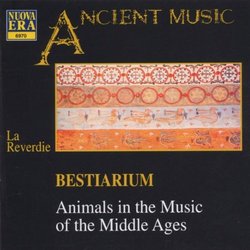| All Artists: Anonymous, Jehan Vaillant, Oswald von Wolkenstein, Jacopo da Bologna, Codex Faenza Anonymous, Italian Anonymous, Trouveres Anonymous, Marcabru, Carmina Burana Anonymous, Donato da Firenze, Irish Traditional, English Anonymous, Breton Traditional, Giovanni da Firenze, Francesco Landini, French Anonymous, La Reverdie, Claudia Caffagni, Livia Caffagni, Elisabetta de Mircovich Title: Bestiarium: Animals in the Music of the Middle Ages Members Wishing: 2 Total Copies: 0 Label: Nuova Era Original Release Date: 1/1/2006 Re-Release Date: 7/11/2006 Album Type: Import Genres: Special Interest, Pop, Classical Styles: Vocal Pop, Opera & Classical Vocal, Historical Periods, Early Music Number of Discs: 1 SwapaCD Credits: 1 |
Search - Anonymous, Jehan Vaillant, Oswald von Wolkenstein :: Bestiarium: Animals in the Music of the Middle Ages
 | Anonymous, Jehan Vaillant, Oswald von Wolkenstein Bestiarium: Animals in the Music of the Middle Ages Genres: Special Interest, Pop, Classical
|
Larger Image |
CD Details |
CD ReviewsThe poor documentation robs this of one star, otherwise supe Leslie Richford | Selsingen, Lower Saxony | 11/05/2007 (4 out of 5 stars) "La Reverdie is an Italian ensemble that has been in existence now for over 20 years and has produced something like 15 CDs, most of which have been greeted enthusiastically by Early Music and "HIPP"-favouring critics. All the CDs are lovingly produced and painstakingly researched, providing both historical accuracy (so far as this is possible with truly "ancient" music) and superb musicianship. The "Bestiarum" appears to have been La Reverdie's debut CD, having been recorded in May 1990 (in the Parliament Chamber of Udine Castle in Italy) and released in 1991 by both Nuova Era and Cantus Records. Cornet player Doron David Sherwin, the only permanent male member of the ensemble, does not appear here as a performer, but is listed as Artistic Director. The four ladies of La Reverdie (Claudia and Livia Caffagni, Ella and Elisabetta de' Mircovich) play their usual assortment of medieval instruments (rebec, santur, lute, tabor, harp, lyre, recorder, fiddle) and also sing with an almost other-worldly beauty and dedication, their voices sounding fresh and innocent. Amazingly, they sing here not only in Latin and Italian, but also in French, Middle English, New High German (Wolkenstein), Middle High German (Ich was ein Chint so wolgetan) and even Breton (Ar bleizi-mor, a 9th century anonymous song about the Norse invaders of Northern France). There are madrigals and solos here, also a few purely instrumental pieces, including a haunting traditional Irish double jig ("Na coire ar na sleibhtibh"). Basically, there are two reasons why I am only giving this four stars instead of the five that my enthusiasm first inclined me to. One is that this "first attempt" by La Reverdie still lacks some of the subtlety and intensity of their later recordings for the Arcana label. Nuova Era's engineering is good, very good in fact, but is not as spacious or as realistic as the later Arcana productions. And the booklet, although adequate, cannot compare with those that were to come later: there is an essay by Ella de' Mircovich in Italian and English, a list of sources for the sung material and a list of the instruments used (including by whom they were made), but the song texts themselves are only printed in the original and in an Italian translation, leaving English speakers to fend for themselves. That is a pity, for this music deserves to be listened to with the utmost attention!"
|

 Track Listings (20) - Disc #1
Track Listings (20) - Disc #1